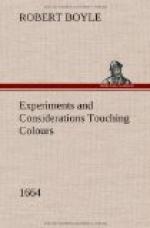The Purple and Red look’d on together appear’d more Scarlet.
The Purple and Yellow made an Orange.
The Green and Red made a Dark Orange Tawny.
The Green and Purple made the Purple appear more Dirty.
The Blew and Purple made the Purple more Lovely, and far more Deep.
The Red parts of the Marbl’d Paper look’d upon with the Yellow appear’d of a Red far more like Scarlet than without it.
[Page 191] But the Fineness or Coarseness of the Papers, their being carefully or slightly Colour’d, and divers other Circumstances, may so vary the Events of such Experiments as these, that if, Pyrophilus, you would Build much on them, you must carefully Repeat them.
EXPERIMENT IV.
The Triangular Prismatical Glass being the Instrument upon whose Effects we may the most Commodiously speculate the Nature of Emphatical Colours, (and perhaps that of Others too;) we thought it might be usefull to observe the several Reflections and Refractions which the Incident Beams of Light suffer in Rebounding from it, and Passing through it. And this we thought might be Best done, not (as is usual,) in an ordinary Inlightn’d Room, where (by reason of the Difficulty of doing otherwise) ev’n the Curious have left Particulars Unheeded, which may in a convenient place be easily taken notice of; but in a Darken’d Room, where by placing the Glass in a convenient Posture, the Various Reflections and Refractions may be Distinctly observ’d; and where it may appear what Beams are Unting’d; and which they are, that upon the Bodyes that terminate them, do Paint either the Primary or Secondary Iris. In pursuance of this we did in the above mention’d Darken’d Room, make observation of no less than four Reflections, and three Refractions that were afforded us by the same Prism, and thought that notwithstanding what was taught us by the Rules of Catoptricks and Dioptricks, it would not be amiss to find also, by hiding sometimes one part of the Prism, and sometimes another, and observing where the Light or Colour Vanish’d thereupon, by which Reflection and by which Refraction each of the several places whereon the Light rebounding from, or passing through, the Prism appear’d either Sincere or Tincted, was produc’d. But because it would be Tedious and not so Intelligible to deliver this in Words, I have thought fit to Referr You to the Annexed Scheme where the Newly mention’d particulars may be at one View taken Notice of.
EXPERIMENT V.
[Illustration: The Explication of the Scheme.]
PPP. An Aequilaterotriangular Crystalline Prism, one of whose edges P. is placed directly towards the Sun.
A B & [alpha] [beta] Two rays from the Sun falling on the Prism at B [beta]. and thence partly reflected towards C & [gamma]. and partly refracted towards D & [delta].
B C & [beta] [gamma]. Those reflected Rays.




